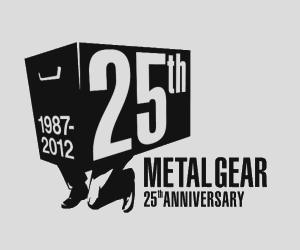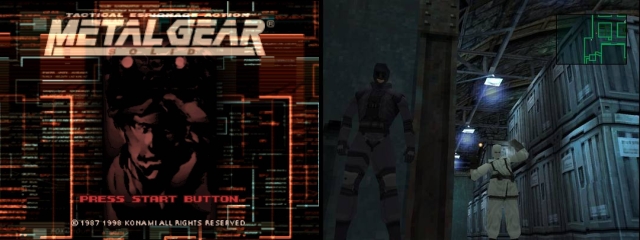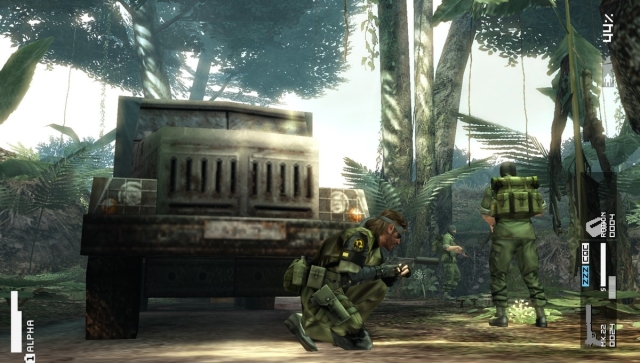Metal…Gear?! Celebrating 25 Years Of Snake
 25 years ago, a game was released on the little-known MSX system that was way ahead of it’s time, and spawned a whole heap of sequels and spin-offs. What better time to gush over one of the greatest series of games? WARNING! Expect possible spoilers.
25 years ago, a game was released on the little-known MSX system that was way ahead of it’s time, and spawned a whole heap of sequels and spin-offs. What better time to gush over one of the greatest series of games? WARNING! Expect possible spoilers.
THIS IS BIG BOSS…OPERATION INTRUDE N313.
PENETRATE THE ENEMY’S OUTER HEAVEN AND DESTOROY THE ULTIMATE WEAPON METAL GEAR!
FIRST, CONTACT MISSING GREY FOX AND SEARCH FOR METAL GEAR!
CONTACT IN THE BAND OF 12085 FROM NOW ON….OVER
The above mess of typos and bad grammar is taken directly from the UK version of the original Metal Gear, on the MSX series of home computers; the first piece of dialogue you see when starting the game. Obviously, the dialogue in later games have benefited from improved localisation, but the narrative is no less nonsensical; for me, the increasingly convoluted plots and insane events are why I love the series.

After a terrible NES port (that didn’t even feature the titular walking tank) and a non-canonical NES sequel (Snake’s Revenge), a true sequel emerged in Japan only, once again for the MSX. Metal Gear 2 was better looking, better sounding and a lot tougher then its predecessor, while also being the perfect showcase for series creator, Hideo Kojima’s penchants for screwing with the player and breaking the forth wall.
It also set the groundwork for the series’ most popular entry, the PlayStation’s (later PC & GameCube) Metal Gear Solid. Practically a 3D update of the second game. Copying scenarios and gameplay elements almost unchanged from its predecessor, it was a landmark in cinematic narrative in video games and a trendsetter in stealth gameplay, spawning a ton of imitators, none of them matching Snake’s exploits.
The PlayStation 2 would see the release of two sequels, MGS2: Sons of Liberty and MGS3: Snake Eater. The second iteration proved to be rather controversal due to the actions of the series’ lead character, Solid Snake, being completely out of the player’s hands; instead putting them in control of the inexperienced Raiden.

Snake Eater progressed the series further, with its focus on a Cold War-era tale of almost Bond-style espionage; arguably the pinnacle of the series, with the game’s exterior environments and themes of survival adding a layer to the stealth action pioneered by the series. Playing as Snake’s father, Naked Snake, the man who would be Big Boss, Snake Eater’s narrative does a great job of merging real-life and fictional events to explain the previous games.
The PSP Portable Ops title finally added a canonical handheld entry to the series (the Game Boy Color entry, Ghost Babel was not canon; neither were the PSP AC!D titles). Naked Snake/Big Boss and Cold War themes were once again the focus, as the gameplay evolved to make use of the PSP’s portability and control limitations. The concept of recruiting your own army was a far cry from the lone hero of previous games, while further bridging the gap in time between Snake Eater and the original Metal Gear.
The PlayStation 3 was home to the “end” of the saga. Metal Gear Solid 4: Guns of The Patriots bravely featured an old, frail and vulnerable Solid Snake as he hunts down Liquid Ocelot (the result of a merging between Snake’s brother, Liquid Snake, and his rival Revolver Ocelot; a ridiculous side-plot that is somehow explained). A game that four years after it’s release, graphically still looks phenomenal. While Guns of The Patriots may not necessarily be the end of Snake, amazingly, the game explains pretty much every facet of the series’ ridiculous story and is a reunion of practically every character from the series. Its final moments are some of the most exhausting, exciting and satisfying conclusions to any series in any form of media.

The last new Metal Gear game to be released was the PSP’s Peace Walker. An evolution of Portable Ops, the game once again saw you controlling Big Boss as he begins to setup an army of soldiers without a country; creating their own Metal Gear and the base that would eventually be known as Outer Heaven.
There are many reasons why I love the Metal Gear series. Hideo Kojima is not afraid to try brave, original things with the medium of video games. From his preference for long cut-scenes and dialogue, to the blatent fourth-wall breaking that takes place in all of his games. These games feature plot-lines and characters that are absolutely crazy and fantastical, yet if you can accept the world that Kojima Productions has created over the past two and a half decades, you can’t help but be lost in it. It’s a series that doesn’t take itself too seriously, but also contains serious messages about topics such as war, society, censorship and nuclear proliferation.
It’s one of those few series’ that every few years or so, I actually play through each game and I still discover new things in them. Every game has its own memorable moments attached to them: The’ fourth wall-breaking psychopathic powers of Pyscho Mantis in MGS, Snake Eater’s gruelling boss fight against The End, hiding in a Cardboard box in almost every game and Guns of The Patriot’s epic final Act.

Speaking of Guns of The Patriot’s final Act, wow, what a way to “finish” a series. One of the final scenes involves Old Snake crawling through a tunnel, while his body is being pounded by microwaves. You are required to constantly tap the Triangle button to keep Snake moving, while the hero is obviously in excruciating pain and close to death. I knew that I didn’t need to tap the button as fast as I was, but I was filled with so much adrenaline that I tapped that Triangle button as if it was me in that tunnel.
It’s a scene that would mean nothing to someone who isn’t familiar with the series. But for those of us who have seen decades of in-game history unfold over the course of the series, from the very start MGS4 constantly gives you the impression that at any time, the unthinkable could happen and that you could witness Snake’s death. The prospect of such a heroic and selfless character actually dying canonically is a genuinely emotional fear within the game.
While none of the Metal Gear games can really be perceived as “perfect”, each one having their own flaws, I have never experienced any series in any form of media that has made me care about its entire universe as much as Metal Gear does. I’m not usually interested in the “extended universe” of games, but I actually find myself regularly loading up the brilliant Metal Gear Database application on the PlayStation 3 from time to time, to learn more about the characters, events and locations that make up the rich tapestry of the Metal Gear universe.
In regards to the future of the series, Metal Gear Rising: Revengeance is on the way, a new chapter of the Metal Gear saga. While Raiden is the lead character, could Snake make some sort of appearance? Then of course there is the promised Metal Gear Solid 5, which is already raising a ton of questions despite nothing being known about the game. Will Snake return?
Anyone reading this article owes themselves the opportunity to partake in the full Metal Gear experience. Start with the MSX games (via the recent Metal Gear Solid HD Collection), then work your way through to the Solid series of games. Ignore the inplausability of the crazy plotlines and enjoy the games and the narrative that surrounds them. Few games have the attention to detail that these games do and I’m sure you find yourself having a memorable gaming experience.
Happy 25th Anniversary, Metal Gear.
Lee Garbutt
I'm a UK-based writer with a passion for gaming that spans over 2 decades. For years I've been interested in the history of video games and as a result I have quite the collection of console hardware, not to mention a brain bursting with gaming trivia and knowledge. I've been a part of the GodisaGeek family since 2011, writing, talking and doing videos throughout that time.
I also have my own YouTube channel, Pug Hoof Gaming (http://www.youtube.com/pughoofgaming) and you can follow that on Twitter @TheLastMetroid
On Twitter I can be located @TheLastMetroid and I can be emailed at lee[at]godisageek.com. I'd love to hear from you!
A veteran GIAG member, I've been writing, talking and taping for the site since 2011




